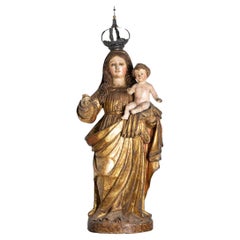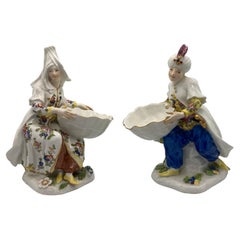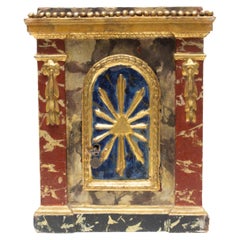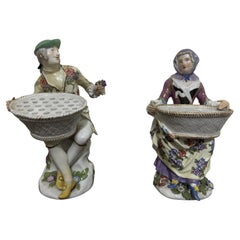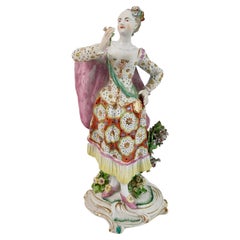Hand-Painted Figurative Sculptures
Late 17th Century Portuguese Baroque Antique Hand-Painted Figurative Sculptures
Gold Leaf
1740s German Rococo Antique Hand-Painted Figurative Sculptures
Porcelain
18th Century Italian Rococo Antique Hand-Painted Figurative Sculptures
Rock Crystal, Gold Leaf
18th Century Italian Rococo Antique Hand-Painted Figurative Sculptures
Gold Leaf
1760s German Rococo Antique Hand-Painted Figurative Sculptures
Porcelain
1760s English Rococo Antique Hand-Painted Figurative Sculptures
Porcelain
Early 18th Century Italian Baroque Antique Hand-Painted Figurative Sculptures
Wood, Lacquer
Mid-18th Century Italian Louis XV Antique Hand-Painted Figurative Sculptures
Fruitwood
17th Century Chinese Chinese Export Antique Hand-Painted Figurative Sculptures
Porcelain
18th Century Italian Rococo Antique Hand-Painted Figurative Sculptures
Rock Crystal, Gold Leaf, Silver Leaf
1750s German Rococo Antique Hand-Painted Figurative Sculptures
Porcelain
1740s German Rococo Antique Hand-Painted Figurative Sculptures
Porcelain
1750s German Rococo Antique Hand-Painted Figurative Sculptures
Porcelain
18th Century Italian Rococo Antique Hand-Painted Figurative Sculptures
Rock Crystal, Quartz
18th Century Italian Baroque Antique Hand-Painted Figurative Sculptures
Rock Crystal, Tourmaline
18th Century Italian Baroque Antique Hand-Painted Figurative Sculptures
Rock Crystal, Carnelian, Malachite
18th Century Italian Rococo Antique Hand-Painted Figurative Sculptures
Rock Crystal
Mid-18th Century Italian Baroque Revival Antique Hand-Painted Figurative Sculptures
Wood
18th Century Italian Antique Hand-Painted Figurative Sculptures
Wood, Paint
17th Century Brazilian Other Antique Hand-Painted Figurative Sculptures
Wood
16th Century German Renaissance Antique Hand-Painted Figurative Sculptures
Wood, Pine
Mid-18th Century English Baroque Antique Hand-Painted Figurative Sculptures
Enamel
18th Century Italian Rococo Antique Hand-Painted Figurative Sculptures
Rock Crystal, Quartz
18th Century Italian Rococo Antique Hand-Painted Figurative Sculptures
Quartz, Rock Crystal
18th Century Italian Rococo Antique Hand-Painted Figurative Sculptures
Quartz, Rock Crystal, Gold Leaf
18th Century Italian Rococo Antique Hand-Painted Figurative Sculptures
Quartz, Rock Crystal, Gold Leaf
18th Century Italian Rococo Antique Hand-Painted Figurative Sculptures
Quartz, Rock Crystal
18th Century Italian Rococo Antique Hand-Painted Figurative Sculptures
Quartz, Rock Crystal
1760s English Antique Hand-Painted Figurative Sculptures
Porcelain
15th Century and Earlier Chinese Tang Antique Hand-Painted Figurative Sculptures
Pottery
18th Century Italian Baroque Antique Hand-Painted Figurative Sculptures
Wood
18th Century Italian Baroque Antique Hand-Painted Figurative Sculptures
Gold Leaf
16th Century Italian Renaissance Antique Hand-Painted Figurative Sculptures
Gesso, Straw
18th Century German Baroque Antique Hand-Painted Figurative Sculptures
Porcelain
18th Century Italian Rococo Antique Hand-Painted Figurative Sculptures
Rock Crystal, Gold Leaf
18th Century Italian Rococo Antique Hand-Painted Figurative Sculptures
Rock Crystal, Gold Leaf
Early 17th Century Spanish Baroque Antique Hand-Painted Figurative Sculptures
Wood
1630s Spanish Renaissance Antique Hand-Painted Figurative Sculptures
Wood
15th Century and Earlier Chinese Tang Antique Hand-Painted Figurative Sculptures
Terracotta
18th Century Italian Folk Art Antique Hand-Painted Figurative Sculptures
Linen, Fruitwood
1740s German Rococo Antique Hand-Painted Figurative Sculptures
Porcelain
Mid-18th Century Italian Baroque Antique Hand-Painted Figurative Sculptures
Gesso, Wood, Paint
18th Century Antique Hand-Painted Figurative Sculptures
Glass, Paint
16th Century Renaissance Antique Hand-Painted Figurative Sculptures
Bronze
18th Century Italian Rococo Antique Hand-Painted Figurative Sculptures
Gold Leaf
18th Century Italian Rococo Antique Hand-Painted Figurative Sculptures
Quartz, Rock Crystal, Gold Leaf
18th Century European Baroque Antique Hand-Painted Figurative Sculptures
Gesso, Wood, Paint
1740s German Rococo Antique Hand-Painted Figurative Sculptures
Porcelain
16th Century European Gothic Antique Hand-Painted Figurative Sculptures
Giltwood
18th Century Italian Baroque Antique Hand-Painted Figurative Sculptures
Glass, Wood
15th Century and Earlier European Gothic Antique Hand-Painted Figurative Sculptures
Oak
16th Century European Gothic Antique Hand-Painted Figurative Sculptures
Stone
1760s English Rococo Antique Hand-Painted Figurative Sculptures
Porcelain
18th Century Italian Baroque Antique Hand-Painted Figurative Sculptures
Rock Crystal, Quartz
18th Century Italian Baroque Antique Hand-Painted Figurative Sculptures
Gold Leaf
18th Century Italian Neoclassical Antique Hand-Painted Figurative Sculptures
Wood, Paint
18th Century Italian Rococo Antique Hand-Painted Figurative Sculptures
Rock Crystal, Amethyst, Gold Leaf
18th Century Italian Rococo Antique Hand-Painted Figurative Sculptures
Quartz, Rock Crystal, Gold Leaf
